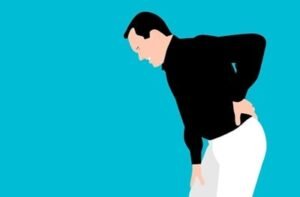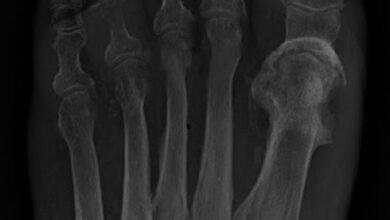
Sciatica can cause excruciating pain that seems like a non-ending nightmare.
This sometimes crippling pain can last for a long time and cause significant lifestyle changes.
Read along so you can learn more about sciatica causes and methods of treatment.
What is sciatica?
It is a pain that affects the sciatic nerve, which branches from the lower back through the thighs and buttocks to the leg.
Sciatica affects a person on one side of the body.
It usually occurs as a result of; narrowing of the vertebral canal, the presence of a bony protrusion in it, or a herniated disc.
In effect, this puts pressure on the sciatic nerve, causing severe pain.
Sciatica causes
There are many causes for sciatica, for example;
- Bone protrusion in the spine.
- Herniated disc.
- Spondylolisthesis or misalignment of the vertebrae.
- Muscular spasm.
- Narrowing of the sciatic nerve due to the presence of a tumor.
- Infection in the spinal cord or vertebral column.
Sciatica risk factors

Some factors increase the risk of acquiring the disease, such as:
- Advancing age.
- Weight gain since it adds pressure on the spine.
- Carrying heavy objects.
- Sitting for a long time.
- Diabetes.
- Smoking.
Sciatica symptoms
Sciatica patients suffer from several symptoms, such as:
- Severe pain extending from the lower back to the leg.
- Pain localization on one side of the body.
- Increase of worsening of pain with movement.
- Pain varies between a burning sensation and pain similar to an electric shock.
- Tingling of the extremities.
- Muscle weakness.
- Pain is aggravated by coughing, sneezing, or even laughing.
Sciatica complications
Most patients recover from it without the need for treatment, but sometimes it can cause permanent nerve damage, resulting in the following:
- Permanent weakness in the affected leg muscle and loss of sensation.
- Loss of bladder control and excretory function.
Facts about sciatica
Sciatica is one of the most common nerve diseases:
- This disease affects those in the age range between 30 to 50 years, and it usually affects pregnant women due to the pressure of the uterus on the nerves, especially the sciatic nerve.
- The incidence of acquiring the disease is four out of ten people.
- The sciatic nerve is the longest nerve in the body.
- Treatment of patients depends on the cause and degree of pain.
- Back pain is; often experienced by patients, but not in all cases.
- The disease does not affect children and those under 20 years of age.
Sciatica diagnosis
The doctor diagnoses the condition by asking the patient about the location of the pain and when it appeared.
He also sometimes asks the patient to walk on his heels or toes or raise his leg without bending his knee.
This medical examination shows whether or not sciatica is causing the pain.
Also, the doctor sometimes uses an MRI and CT scan to determine the location of the pain and the course of treatment.
Sciatica treatment
There are many ways to treat this disease, and the choice of treatment plan depends on the patient’s condition and the severity of the injury.
The type of treatment also depends on the principal cause of the pain.
Drug therapy
There are oral analgesic pills, cortisone injections, or superficial paints on the skin.
Sedatives
It is not preferable to take a lot of painkillers; To avoid stomach ulcers or bleeding.
But when the pain intensifies, it can be taken, such as ibuprofen or aspirin.
Cortisone injections
Doctors sometimes prescribe cortisone injections to reduce inflammation, which can be given directly into the spinal cord.
Antidepressants
Sometimes antidepressants are used to raise the level of endorphins; Which helps relieve pain.
Creams and ointments
The patient may think that the use of creams and ointments treats or improves the situation.
But actually, it only helps to hide the pain for a short period of time.
Muscle relaxant
The muscle relaxant helps reduce muscle congestion and spasm; Which helps reduce pain.
Exercise therapy
Exercising, such as swimming or cycling, helps release endorphins, which in turn reduce body pain.
Physical therapy
You can go to a physical therapist with experience in this condition to help improve your posture and support your back muscles.
Meanwhile, avoid performing the wrong exercises and adhering to the correct steps to prevent worsening the condition.
Sciatica related exercises
Your doctor may advise you to do several exercises, such as:
Muscle stretching exercises
Stretching exercises are not ideal for treating pain, but they can reduce inflammation.
The doctor trains the patient to do some exercises that can be, performed at home.
Straight leg raise exercise
This exercise helps to strengthen the abdominal muscles and prevent the recurrence of sciatica.
Lie on your back, bend your knees, put your legs on the floor.
Lay with one leg flat on the floor, gently lift 6 to 8 inches off the floor, and then return to the floor and can be repeated ten times.
Prone Leg Exercise
This exercise helps relieve sciatica pain by training the body to maintain a comfortable position for the spine and pelvis.
The patient lies on his stomach, arms at his sides and legs in a straight position, then begins to raise one leg at a time alternately about 2 inches off the ground.
Abdominal Curl-up Exercise
This exercise strengthens the lower abdominal muscles and relieves sciatica pain.
The patient lies on his back and folds his arms on his chest.
He then raises the head from the ground for 2-4 seconds, returns to lie down again, and repeats ten times.
Surgery
Surgery is performed in case of severe pain, loss of bladder control, or severe weakness in the lower body extremities.
The goal of surgery is to remove part of the herniated disc or any bulge pressing on the nerves.
Who needs surgery?
Usually, 5-10% of patients need surgery when the pain persists for more than three months or when the condition worsens; and complications occur.
Home treatment
A water bottle can be placed on the sore site, alternating between hot and cold water for 20 minutes every two hours.
This step reduces pain and inflammation.
Acupuncture
Acupuncture is involved in treatment, and its use has become popular recently.
Moreover, it can contribute to reducing pain by removing any blockage of blood flow.
However, it must be used by; an authorized person.
Sciatica and pregnancy
50-80% of pregnant women experience back pain during pregnancy, and it rarely develops into sciatica.
But sometimes, the uterus presses on the nerves, especially the sciatic nerve, causing this condition.
Generally, the persistence of pain depends on the position and weight of the fetus, and the pain ends immediately after birth.
A pregnant woman may not be able to; use medication, but she can exercise, do yoga, or body massage to reduce pain.
You must listen for body pain and stop any activities that increase its severity.
Exercises for pregnant women with sciatica
- The pregnant woman can sit on a chair, put the heel of the affected leg on the knee of the other leg, then lean her body forward until she feels the tension in the lower back, wait for 30 seconds, and then return to its normal position.
- The pregnant woman can stand in front of the table, then lean her body on the table with the legs apart and arms straight, and she can move the pelvis a little to increase the tension, wait for 30-60 seconds, and then stand again.
Sciatica prevention
Unfortunately, sciatica can not be completely prevented, especially if it was recurrent.
However, some steps can contribute to reducing the rate of its recurrence, such as;
- Exercising regularly.
- Swimming and walking.
- Maintaining a correct posture of the body all the time.
- Bending the knees when lifting heavy objects.
- Avoiding taking the same position for a long time, whether sitting or standing.
- Avoiding high-heeled shoes.
False sciatica
Sometimes the patient feels very similar pain, but the difference between them lies in the location of the pain.
The patient feels pain in the buttock and thigh area more than the back, and the pain extends to the whole leg.
Does sciatica pain ever stop?
In most cases, the pain goes away on its own within a few weeks.
However, sometimes, the patient needs surgery, as mentioned before.
Finally, sciatica causes pain similar to many diseases, so you should go to the doctor when you feel any symptoms to avoid aggravating the situation or developing complications.
Read also,
Cellulitis | Causes and treatment options
The most common symptoms of rheumatic diseases | Causes and treatment



